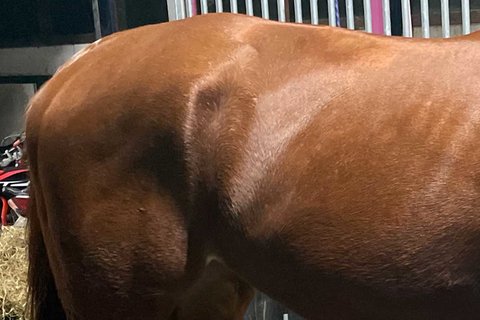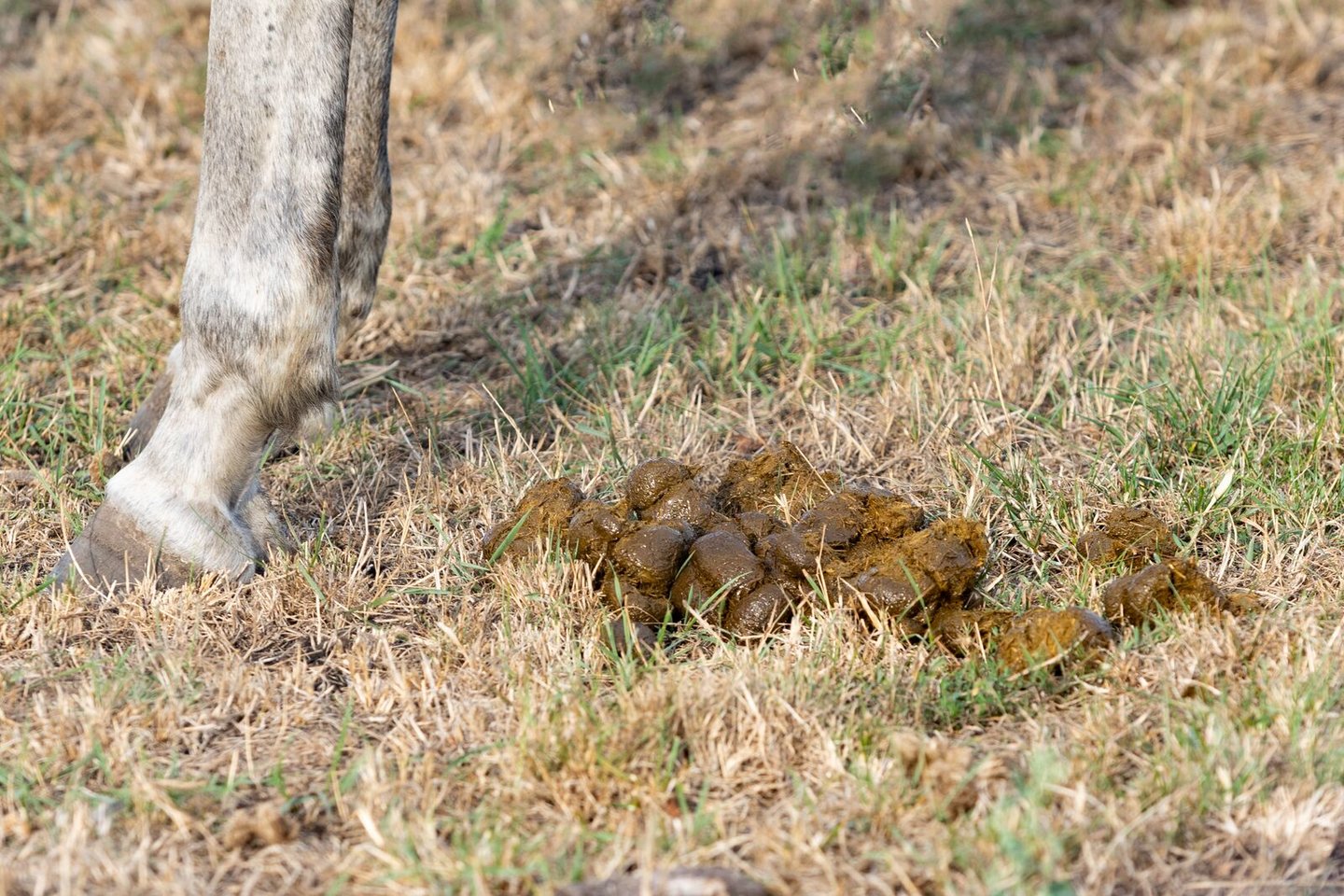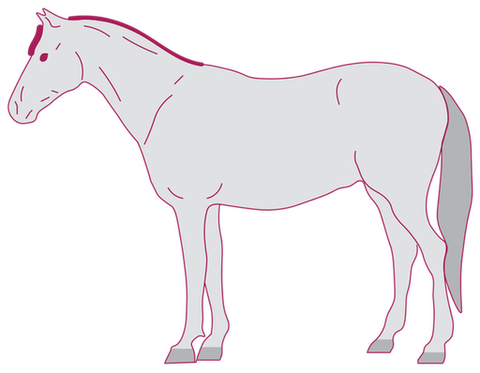Opdag symptomerne
Behaviour
En anden god indikation for smerte eller utilpashed hos hesten, er pludselige ændringer i adfærden, eller at man oplever unormal adfærd. Dette er nogle unormale adfærdsmønstre der ofte ses hos heste der lider af mavesår, listet i tabellen nedenunder.
Ændre din hest pludselig adfærd, bliver mere nervøs eller viser aggressiv adfærd?

Adfærdsmønstre er værdifulde i forhold til at spotte smerte eller ubehag hos hesten. Forskellige adfærd, som ofte ses ved heste der lider af mavesår, er når hesten…:
- Æder mindre end den plejer
- Æder slet ikke
- Spilder kraftfoderet
- Skære tænder
- Bevæger meget tunge og læber
- Gaber meget og ofte
- Reagere smertfuldt, aggresivt eller surt, ved berøring i området omkring maven, eller spænde gjord
- Virker mere søvning, ikke opmærksom, med langsom reaktion
- Pludselig ikke følge med i arbejde, skal bruge mere rekreationtid efter træning
- Krybbebidning: Sliber overfladen med tænderne, strækker halsen, skubber kroppen tilbage og laver en bøvselyd
Fordøjelsen
Kolik: forskellige former for kolik
Kolik er en samlet betegnelse for mavekramper/ smerter, som kan være meget farlige for hesten, og endda resulterer i død. Det er ofte et resultat af en svækket funktion i fordøjelseskanalen. Hos hesten kan kramper, forstoppelse, (gas) ophobning eller forskydninger opstå forskellige steder i fordøjelseskanalen, som ofte resulterer i kolik. Der er forskellige typer af kolik:

- Gas kolik: Når gasser formes i fordøjelseskanalen og hesten ikke kan komme af med det, er der en øget risiko for gaskolik.
- Forstoppelses kolik: Denne form for kolik opstår, når tarmene er fyldt med foder. Det kan være når de æder for meget halm, ikke tygger foder nok/ korrekt, eller drikker for lidt vand.
- Sand kolik: Når hesten indtager for meget sand, kan sandet hobe sig op i tarmene og resultere i sandkolik.
- Krampe kolik: Stress eller hurtige ændringer (eksempelvis foderskifte eller omgivelser) kan give kramper i tarmene.
Immunitet

Hestens stortarm består af forskellige bakterier, svampe og protozoer, også kaldet mikro- eller tarmfloraen. Som tidligere nævnt er mikrofloraen meget vigtig for fermentering af enzymatiske ufordøjelige fibre, og derigennem gerenere det daglige energi behov for hesten. Men, udover den utroligt vigtige fermenterings process, har mikrofloraen et samspil med immunforsvaret. Omkring 80% af immunforsvaret integrere med fordøjelseskanalen. Via den intigering beskytter mikrofloraen hesten at ved eleminere bakterier. Derfor kan et sundt fordøjelsessytem hjælpe til at reducere risikoen for andre sundheds problemer. En sund og balanceret mikroflora vil støtte og hjælpe immunforsvaret.
Pels kvalitet
Pels kvalitet reflekterer den totale sundheds-status hos din hest. En dårlig pelskvalitet er allerede en af de første tegn på sundheds-relaterede problemer, utilstrækkelige næring eller ringe tilstand. En flot skinnende pels reflekterer en sund tilstand, og en dårlig pels ses ofte ved heste med ringe helbred.
Vær venligst opmærksom på at tage disse tegn alvorligt, og ikke bare prøve at gøre pels skinnende igen med diverse plejeprodukter eller mere olie.


Different coat quality's with first a dull or dry coat then a sleek, glossy, nice coat.
Hestepære kvalitet
Kvaliteten af afføringen hos din hest, er et meget godt parameter for sundheden i fordøjelseskanalen hos din hest. En sund hest, med en sund mikroflora, vil generelt have en god kvalitet af afføring.
Afføring i god kvalitet, vil bestå af faste, skinnende hestepærer, der falder fra hinanden, når de lander på Jorden. Der er nogle variationer af (sund) afføring, afhængig af situationen og føde. Normalt skal det være brunt, men under græssæsonen vil det blive mere mørkegrønt og mere vådt, og ved fodring af mere tørt hø og halm bliver farven med gul-agtig og mere tør. Du vil også se flere fibre i hestepærerne.
Voksne heste (600 kg) producer omkring 17,5 kg hestepærer dagligt. Hvis en hest pludseligt producere mere eller mindre end normalt, kan dette ofte reflektere til ændringer i ratioen eller stress.


Is my horse at a goodweight?

The body condition of the horse is another good health indication in the horse.
If your horse is al of a sudden losing a lot of weight, without changing the diet or exercise,, it should ring your alarm clocks. It is very important to always keep an eye on your horses weight and body condition.
When determining the body condition score (BCS), we look at six different areas: the neck, withers, back, base of the tail, ribs and the area just behind the shoulder of your horse.
On the illustration on the left, the points you need to look at are clearly indicated. These are important to read a good BCS of your horse.
By using the illustrations and description below, you can see which score your horse has for each area. The average of these scores determines the final body condition score. Be honest when filling this in, even though it can sometimes be quite confronting.

“We recommend to check your horses weight on a regular basis. The BCS is a helpful tool for this. If you want to measure the weight without a scale, you can also use the Pavo measurement tape.”
Pleun Broeren, nutritionist

1.
Extremely thin
The bone structure at the neck, shoulder and withers can be easily felt. On the back, the spinous processes are visible, as are the ribs. The base of the tail protrudes clearly. No fatty tissue can be felt.

2.
Very thin
The bone structures at the neck, shoulder and withers are vaguely discernible. The spinous processes can be felt, as can the base of the tail. The ribs are visible.


3.
Thin
The bones in the neck, shoulder and withers are accentuated, but no bone structure can be discerned. The transverse processes can no longer be felt. The base of the tail can be felt, but individual vertebrae are no longer visible. The ribs can still be seen, but are lightly covered with fat.

4.
Moderately thin
The neck, shoulder and withers are not excessively thin. A slight ridge is visible along the spine. The degree to which the base of the tail protrudes depends on the body's build, and some fatty tissue can be felt. You can see a vague outline of the ribs.


Producttip
When you recognize your horse needs to gain more weight, Pavo FibreBeet can support your horse.
The prebiotic effect of the pectins supports the growth of healthy intestinal bacteria. This makes the beet pulp easily digestible and particularly suitable for horses with a sensitive intestinal flora and for horses that have problems with diarrea, faecal water or colic

5.
Moderate
The neck and shoulder flow into the body. The withers are rounded. The fatty tissue around the tail insertion begins to feel spongy. The ribs cannot be distinguished with the naked eye, but can easily be felt.

6.
Moderately fleshy
Fatty tissue starts to develop around the neck, just behind the shoulder and on the side of the withers. A slight thickening is possible along the spine. The fatty tissue around the base of the tail feels soft. The fatty tissue over the ribs feels spongy, but you can still feel the ribs.



7.
Fleshy
Fat deposits at the level of the neck, the withers and behind the shoulders. A slight thickening along the spine is possible. The fatty tissue around the base of the tail feels soft. Individual ribs can still be felt, but there is noticeable padding with fatty tissue between the ribs.

8.
Obesity
The neck is noticeably thickened. The withers and the area just behind the shoulder are filled with fatty tissue. There is a thickening along the spine. The fatty tissue around the base of the tail feels very soft. The ribs are difficult to feel due to fat.


9.
Extreme obesity
At the neck, withers, at the base of the tail and just behind the shoulder, there is excessive, bulging fatty tissue. Fat along the inside of the buttocks can rub against each other and the flanks are filled to the same degree as the body, so that the body and the flanks run into each other. Along the spine, a very clear thickening can be seen. Over the ribs there is also generous fatty tissue, so that you cannot feel the ribs.
Pavo HealthBoost
De krachtige opkikker voor ieder paard

Pavo HealthBoost contains a wide range of vitamins, antioxidants and prebiotics, making it a real boost for your horse. The natural vitamin E, in combination with the natural CellProtect antioxidants, provide an even better availability of vitamin E and the neutralisation of the free radicals. Immunity is closely related to a proper functioning of the digestive system. Live yeast is often used as a prebiotic that contributes to a healthy micro flora in the guts.
However, research has shown that live yeast loses much of its effectiveness by the processing into a product. This is why Pavo adds ‘Diamond V’ prebiotics to its HealthBoost. Diamond V contains nutrients that are required by healthy gut bacteria, allowing them to thrive.
No iron is added, as years of monitoring of the iron levels in roughage have shown that iron is available abundantly. Pavo HealthBoost does not contain wheat, so this supplement is also ideal for horses that are sensitive to gluten.
Important characteristics
- Powerful boost after sickness or a difficult period
- Supports the immune system and the intestinal health
- Contains vitamins, prebiotics and natural antioxidants
Application
- For horses that have been sick or have a weakened condition
- For horses that need support of their immune system
- For listless horses that could do with a bit of extra energy
- For horses that are for unknown reasons out of sorts
Feeding advice
- Give Pavo HealthBoost as a treatment during two to three weeks after sickness, or for a longer period of time for horses that suffer from a weakened immunity.
- Horse (approx. 600 kg): 250 grams per day
- Pony (approx. 300 kg): 125 grams per day
Pavo FibreNuggets
Pavo FibreNuggets as an alternative to roughage

Sufficient, high-fibre and high-quality roughage is the staple for every horse’s diet, however, this is not always self-evident. In some cases, it might be necessary to supplement or even replace your hay or silage wholly or partially. For example, in case of a poor or mediocre quality of roughage, or horses that suffer from teeth problems and consequently have difficulty taking in roughage.
Pavo FibreNuggets can be used as a high-quality replacement of roughage. The large high-fibre pellets, made from 100% pasture grass from the Alpine foothills in Southern Germany, stimulate chewing and salivation in your horse. More chewing prevents boredom and saliva promotes a healthy digestion. The fragrant and tasty pasture grass consists of a variety of more than 60 different types of grasses and herbs. It is rich in fibres, natural vitamins and trace elements and completely free of molasses and cereals. Thanks to a controlled drying process, the FibreNuggets are of a very consistent quality without mould or dust. This also makes it the ideal replacement for horses that are sensitive to dust and/or mould.
Important characteristics
- Top quality roughage replacement
- Tasty mixture of Alpine grasses and herbs
- Contains more than 60 different grasses and herbs
- Free of molasses and cereals
Application
- Suitable for all horses and ponies
- Supplement or whole or partial replacement of roughage in case of poor or bad roughage quality
- Senior horses or horses that have a problem with roughage intake due to teeth issues
- For horses that are sensitive to dust/mould in roughage
Feeding advice
- Pavo FibreNuggets can be fed dry, but for optimum safety we recommend soaking the pellets with sufficient water, in a ratio 1:2 (FibreNuggets : water). Soak the product for 30 minutes in hot water or 1 hour in cold water.
- Feed maximum 0.5 - 1 kg per 100 kg body weight per day.
1 full Pavo feed scoop FibreNuggets contains approximately 0.860 kg.
Pavo Mobility
Pavo FibreNuggets as an alternative to roughage

Optimum movement requires healthy joints. The right nutrients can have a positive effect on the condition of the cartilage, synovial fluid and the joint capsule and ligaments that keep the joint together.
Supple joints with Pavo Mobility
Pavo Mobility contains glucosamine and hyaluronic acid that are components for healthy synovial fluid. Chondroitin and MSM (sulphur) have a positive effect on the cartilage. On the cartilage yet these substances alone are not enough to support healthy joints in horses. The most important component is the special collagen in Pavo Mobility that supports the collagen, bone and cartilage. Pavo Mobility also contains vitamin C and the micro-mineral silicon that plays a role in the development of bone tissue, cartilage, collagen and hyaluronic acid. Pavo Mobility does not contain wheat, so it is gluten-free.
Important characteristics
- For supple joints
- Optimum nutrients for cartilage and joints
- Supports the creation of synovial fluid
- With collagen, glucosamine, chondroitin, hyaluronic acid, MSM and silicon
Application
- For horses that need support for their joints
- For competition horses
- For young horses that have just started their training
- For older horses
Feeding advice
Pavo Mobility can be administered as a preventative to competition horses when the joints are under a lot of strain. Additionally, Pavo Mobility can be given after an injury, if your horse had joint problems or upon indication of a veterinarian that your horse could benefit from it during a period of two to three months. Senior horses as well as horses with arthrosis may benefit from Pavo Mobility.
Preventatively:
Horse (approx. 600 kg): 50 grams per day
Pony (approx. 300 kg): 25 grams per day
As a treatment and for senior horses:
Horse (approx. 600 kg): 100 grams per day
Pony (approx. 300 kg): 50 grams per day

Behavior

Coat quality

Digestion

Immunity

Manure

Weight






